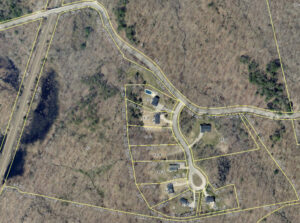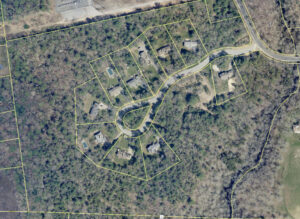Charlestown Has 22 Years of Mandatory Cluster Subdivision
At the July 11 presentation on Conservation Development, Scott Millar of GrowSmartRI, included, as examples of good land use, some existing Charlestown subdivisions in his presentation. These four subdivisions had been developed under the existing Cluster Development, and it was explained that subdivisions like these could be developed in much the same way under Conservation Development. Under current Cluster Development, which has been mandatory for subdivisions of six or more lot for 22 years, subdivision of land in the R3A zone in a number of cases, such as the examples shown, has resulted in lots of about 40,000 square feet (approximately 1 acre), with approximately 67% to 70% of the parcel as surrounding open space. These lot sizes would be possible under Conservation Development, but lot layout could be varied a bit so that many of the restrictions on many of these existing lots would not be necessary under Conservation Development. For example, rather than placing no-cut buffers on the rear of lots that extend into wetland buffer areas, those areas could become part of the open space and the lot would not be quite as deep.
Click on any image below to start a slide show
Conservation Development would first locate any important natural resources on the land so that the house lots could be positioned to avoid those resources. If desired and advisable, lots could have different characteristics, such as different frontage requirements, and the overall size could be reduced to match limits of disturbance requirements from the Department of Environmental Management, resulting in lots with no restrictions.
Conservation Development would allow for reduced environmental impacts, but existing layouts as shown in these examples would still be possible.




July 21, 2022 @ 1:31 pm
Could someone please explain to me in simple terms the pros and cons of this proposal. Why can’t we maintain what we currently have on the books. Why is this change better ?
July 23, 2022 @ 11:00 am
My answer to Mr Greene’s question above …. with 2 introductory comments; a) my wife Frances is vice chair of the planning commission … and b) she has a far deeper understanding of this proposal than I do as she has the patience and interest to study them fully whereas I have neither. So here is my “kindergarten level” understanding:
We can maintain what we have on the books, and will for conventional subdivisions which are for 5 or fewer lots. There are many aspects of the current regulations that remain in place.
This proposal ONLY applies to parcels of land that are of sufficient size to be developed into a 6 or more residential lot major subdivisions under the current regulations, AND it does not increase or decrease the yield or number of lots which remains the same. The Planning Commission only reviews when a developer seeks to subdivide and makes an application.
The advantage of the new regulations would be that decisions as to where the lots are located is done up front in sketch form in consultation between the developer and the Planning Commission before expensive engineering is done. With maps that are readily available, areas of wetland, good soils, soils suitable for building on and maintaining wells and septics, steep slopes, water bodies and large tracts of forest that are valuable left intact can be identified and lots placed in the best location hopefully protecting resources, while providing a pleasant area to live in. Regulations ensure that suitable wells and septics are possible before any hard lines are drawn so a smaller lot must still be viable and not pollute groundwater.
It allows for flexibility of lot size and frontage down to 20 feet if creating a longer driveway. This might not always be needed but is an option that would benefit both developer and Charlestown. Protecting groundwater and natural resources, with increased pressure to develop, is a major goal without the developer losing out. What is in it for them; less expensive roads to build and lots that generally go for more than conventional ones. Although some people like large lots there are many already in Charlestown and conventional subdivisions will still be developed. Others may prefer smaller lots, lower maintenance, neighborliness. Charlestown benefits by keeping nice views, scenic byways, cultural assets, protecting resources for example.
The proposal would allow alternative designs where lot sizes might vary from one size fits all and fit the land better, and the remainder undisturbed land would be owned jointly by the lot owners as a Home Owners Association where each has a proportionate interest, or by the town or other entity if the owner/developer wants to do this and it is agreed on. So far that has not happened, it is usually a Home Owner’s Association. It remains part of the subdivision. Sizes could vary from 1.5 acre to half an acre for example and let them be clustered in the preferred spot.
What are the pros and cons of this?
a) Many residents of Charlestown are retired and/or elderly … or they both work full time …. and some of these neither have the time and/or interest and/or energy for lot maintenance of a large 1 acre lot or more depending on the zoning…. yet they like access to additional space and know it will not be built on further.
b) The cost to develop the subdivision is reduced by the shorter roads and driveways needed.
c) A study done by realtors shows that in general the subdivisions planned by the new approach have higher value than “traditional” ones.
d) So c) minus b) means that the developers make more money ….. and the house owners prefer the more convenient lot sizes …….. the undisturbed land better protects the groundwater, wildlife and provides recreational space, and the town saves money longterm on road maintenance. So why are some folks so against this proposal? Would they like to see Charlestown become more like neighboring towns of Westerly, South Kingstown , Narragansett etc. more dense with less open space or do they fear developers will lose money which seems unlikely. Once sold to a developer, previous land owners are generally out of it unless they are developing it themselves. The pressure for development has increased and natural resources need protection.
July 23, 2022 @ 11:20 am
July 13, 2022 @ 6:52 pm
Hi,
If any or you can make the July 14th Town Council meeting, 7:00 to support conservation development, it would be greatly appreciated. A flyer was mailed out (by a lawyer? who at times has represented developers of large development projects ) to a select group of people. This in turn caused a large group of, what appeared to be, misinformed people to come in highly upset. I do not believe these people represent the overall wishes of town residents.
July 13, 2022 @ 4:35 am
People who say the lot owner should be able to do whatever he/she wants to do with their property obviously do not understand the concept of land classification and zoning regulations. Both protect the homeowner from encroachment and land use practices inimicable to the neighborhood. Conservation measures properly employed can enhance the value of the property over time and the aesthetic appeal of the neighborhood.